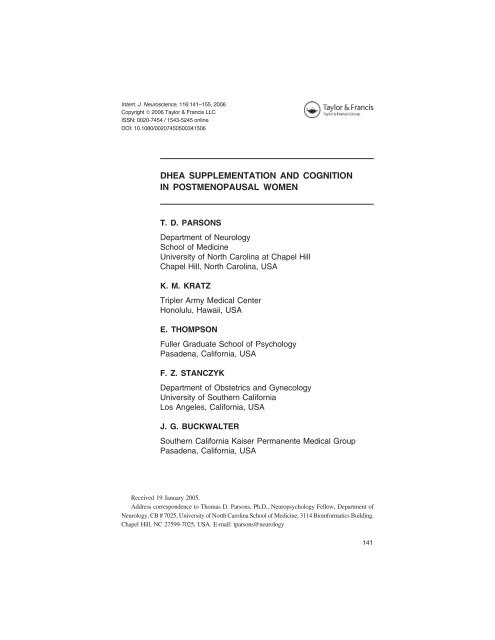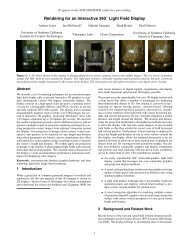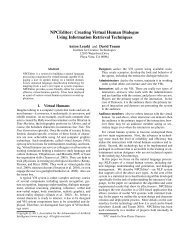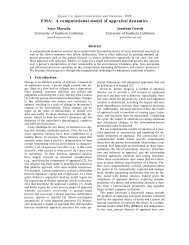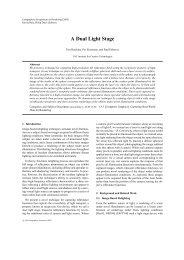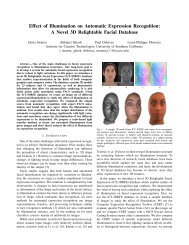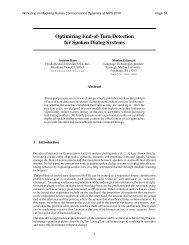dhea supplementation and cognition in postmenopausal women
dhea supplementation and cognition in postmenopausal women
dhea supplementation and cognition in postmenopausal women
Create successful ePaper yourself
Turn your PDF publications into a flip-book with our unique Google optimized e-Paper software.
Intern. J. Neuroscience, 116:141–155, 2006<br />
Copyright © 2006 Taylor & Francis LLC<br />
ISSN: 0020-7454 / 1543-5245 onl<strong>in</strong>e<br />
DOI: 10.1080/00207450500341506<br />
DHEA SUPPLEMENTATION AND COGNITION<br />
IN POSTMENOPAUSAL WOMEN<br />
T. D. PARSONS<br />
Department of Neurology<br />
School of Medic<strong>in</strong>e<br />
University of North Carol<strong>in</strong>a at Chapel Hill<br />
Chapel Hill, North Carol<strong>in</strong>a, USA<br />
K. M. KRATZ<br />
Tripler Army Medical Center<br />
Honolulu, Hawaii, USA<br />
E. THOMPSON<br />
Fuller Graduate School of Psychology<br />
Pasadena, California, USA<br />
F. Z. STANCZYK<br />
Department of Obstetrics <strong>and</strong> Gynecology<br />
University of Southern California<br />
Los Angeles, California, USA<br />
J. G. BUCKWALTER<br />
Southern California Kaiser Permanente Medical Group<br />
Pasadena, California, USA<br />
Received 19 January 2005.<br />
Address correspondence to Thomas D. Parsons, Ph.D., Neuropsychology Fellow, Department of<br />
Neurology, CB # 7025, University of North Carol<strong>in</strong>a School of Medic<strong>in</strong>e, 3114 Bio<strong>in</strong>formatics Build<strong>in</strong>g,<br />
Chapel Hill, NC 27599-7025, USA. E-mail: tparsons@neurology<br />
141
142 T. D. PARSONS ET AL.<br />
Previous work has suggested that DHEA <strong>supplementation</strong> may have adverse<br />
cognitive effects <strong>in</strong> elderly <strong>women</strong>. This article analyzed 24-h measurements of<br />
DHEA, DHEAS, <strong>and</strong> cortisol to determ<strong>in</strong>e if cognitive decrease with treatment<br />
is mediated by DHEA’s impact on endogenous cortisol. It was found that DHEA<br />
adm<strong>in</strong>istration <strong>in</strong>creased cortisol at several hours dur<strong>in</strong>g the day. In the treatment<br />
group, cortisol was positively associated with <strong>cognition</strong> at study completion.<br />
An <strong>in</strong>crease <strong>in</strong> negative associations between DHEA(S) levels <strong>and</strong> <strong>cognition</strong><br />
was found at completion. Increased cortisol does not expla<strong>in</strong> the cognitive<br />
deficits associated with DHEA, suggest<strong>in</strong>g a direct negative effect of exogenous<br />
DHEA on <strong>cognition</strong>.<br />
Keywords <strong>cognition</strong>, cortisol, dehydroepi<strong>and</strong>rosterone (DHEA), dehydroepi<strong>and</strong>rosterone<br />
sulfate (DHEAS), <strong>postmenopausal</strong>, <strong>women</strong><br />
The neuropsychology of steroid hormones is a burgeon<strong>in</strong>g area of research.<br />
Dehydroepi<strong>and</strong>rosterone (DHEA) is an adrenal <strong>and</strong>rogen that decl<strong>in</strong>es with<br />
age (Orentreich et al., 1984; Sulcová et al., 1997). Researchers have hypothesized<br />
DHEA as a possible marker of ag<strong>in</strong>g <strong>and</strong> longevity (Roth et al., 2002).<br />
Because of its reported positive neural effects, <strong>in</strong>clud<strong>in</strong>g possible enhancement<br />
of <strong>cognition</strong>, DHEA <strong>supplementation</strong> has been advocated as a powerful<br />
anti-ag<strong>in</strong>g tool. DHEA also appears to have an agonist-antagonist relationship<br />
with the adrenal hormone cortisol <strong>in</strong> neural function<strong>in</strong>g, physical health,<br />
<strong>and</strong> <strong>cognition</strong> (Browne et al., 1993; Kalimi et al., 1994; Wolf & Kirschbaum,<br />
1999; Ferrari et al., 2004; Marklund et al., 2004). However, a clear relationship<br />
between DHEA <strong>and</strong> cortisol, especially as they collectively impact <strong>cognition</strong>,<br />
has yet to be identified. Given the role of DHEA as a precursor to<br />
other more potent steroid hormones, its oppos<strong>in</strong>g relationship to cortisol, <strong>and</strong><br />
its current use as an anti-ag<strong>in</strong>g supplement, a comprehensive study of its<br />
direct <strong>and</strong> <strong>in</strong>direct effects on <strong>cognition</strong> <strong>and</strong> cortisol is warranted. Of specific<br />
<strong>in</strong>terest is an exploration of the effects of DHEA <strong>in</strong> a population of <strong>postmenopausal</strong><br />
<strong>women</strong>.<br />
Studies on DHEA <strong>supplementation</strong> <strong>and</strong> <strong>cognition</strong> <strong>in</strong> older adults have not<br />
provided consistent results (Racchi et al., 2003; Vallee et al., 2001). One study<br />
by Wolkowitz et al. (1997) showed an improvement <strong>in</strong> <strong>cognition</strong> follow<strong>in</strong>g<br />
DHEA adm<strong>in</strong>istration <strong>in</strong> six cl<strong>in</strong>ically depressed middle-aged, <strong>and</strong> elderly,<br />
patients. However, this study has a low subject number, the researchers did not<br />
control for placebo effects or for improvement <strong>in</strong> mood, <strong>and</strong> cognitive improvement<br />
was only found on a verbal memory subtest measur<strong>in</strong>g automatic<br />
process<strong>in</strong>g. No improvement was found on other <strong>in</strong>dices of the test, such as<br />
those measur<strong>in</strong>g free recall, re<strong>cognition</strong>, vigilance/attention, or fluency.
DHEA SUPPLEMENTATION 143<br />
Other studies showed no effect on <strong>cognition</strong> follow<strong>in</strong>g DHEA adm<strong>in</strong>istration<br />
(Berr et al., 1996; Burkenhäger-Gillesse et al., 1994; Yaffe et al.,<br />
1998). In a study by Wolf, Neumann, et al. (1997), no effect or detrimental<br />
effects on <strong>cognition</strong> were found follow<strong>in</strong>g DHEA adm<strong>in</strong>istration, despite <strong>in</strong>creased<br />
levels of DHEA. The neuropsychological tests utilized <strong>in</strong> these studies<br />
<strong>in</strong>cluded two uncited measures <strong>and</strong> did not comprehensively measure nam<strong>in</strong>g<br />
<strong>and</strong> visuospatial abilities, which are known to be sensitive to hormonal fluctuation<br />
(Henderson et al., 1996; Caldwell & Watson, 1952; Kampen & Sherw<strong>in</strong>,<br />
1994; Phillips & Sherw<strong>in</strong>, 1992a, 1992b; Sherw<strong>in</strong>, 1988).<br />
In terms of sex difference, some studies have found a l<strong>in</strong>k between DHEAS<br />
<strong>and</strong> cognitive function among men, but no difference among <strong>women</strong> (Mazat<br />
et al., 2001; Tilvis et al., 1999; Ravaglia et al., 2002). Contrariwise, other<br />
studies report a positive correlation between DHEAS <strong>and</strong> cognitive impairment<br />
among <strong>women</strong> (see Morrison et al., 2000). In another study, Kratz et al.<br />
(1999, 2000) found detrimental effects of DHEA <strong>supplementation</strong> <strong>in</strong> several<br />
cognitive doma<strong>in</strong>s for menopausal <strong>women</strong>. Yet Kratz utilized a s<strong>in</strong>gle hormonal<br />
sample to evaluate <strong>cognition</strong> at basel<strong>in</strong>e <strong>and</strong> study completion, <strong>and</strong><br />
failed to exam<strong>in</strong>e the impact of DHEA on plasma cortisol levels.<br />
In a study attempt<strong>in</strong>g to expla<strong>in</strong> DHEA’s complex effects on <strong>cognition</strong><br />
<strong>in</strong> <strong>postmenopausal</strong> <strong>women</strong>, Hirshman et al. (2004) argue that the varied effects<br />
of sex steroids across tasks emphasize the significance of identify<strong>in</strong>g<br />
the particular cognitive mechanisms <strong>in</strong>fluenced by sex steroids. However,<br />
studies of DHEA’s impact on cortisol level <strong>and</strong> <strong>cognition</strong> tend to provide<br />
<strong>in</strong>consistent results. A s<strong>in</strong>gle dose of DHEA decreased cortisol but did not<br />
enhance verbal or visual memory <strong>in</strong> young males (Wolf, Köster, et al., 1997).<br />
Treatment with DHEA for 3 months decreased morn<strong>in</strong>g cortisol by 13.2%<br />
but did not change basel<strong>in</strong>e <strong>cognition</strong> <strong>in</strong> 60 <strong>postmenopausal</strong> <strong>women</strong> (Barnhart<br />
et al., 1999). Surpris<strong>in</strong>gly, adm<strong>in</strong>istration of DHEA <strong>in</strong> a double-bl<strong>in</strong>d, placebocontrolled<br />
study was accompanied by an <strong>in</strong>crease <strong>in</strong> free cortisol follow<strong>in</strong>g a<br />
laboratory stress test <strong>and</strong> a decrease <strong>in</strong> visual memory (Wolf et al., 1998).<br />
Thus, there are no methodologically sound studies to support the adm<strong>in</strong>istration<br />
of DHEA to improve <strong>cognition</strong> that take <strong>in</strong>to account the possible<br />
negative impact of cortisol on <strong>cognition</strong>. No studies have exam<strong>in</strong>ed the complex<br />
relationship between <strong>cognition</strong> <strong>and</strong> 24-h DHEA(S) <strong>and</strong> cortisol levels.<br />
Further research <strong>in</strong> this area is needed before DHEA <strong>supplementation</strong> can be<br />
soundly recommended <strong>in</strong> older age groups.<br />
The aim of this project was to follow up on the previous r<strong>and</strong>omized,<br />
placebo-controlled double bl<strong>in</strong>d study by Kratz, which suggested that DHEA<br />
<strong>supplementation</strong> may have adverse cognitive effects <strong>in</strong> elderly <strong>women</strong>. Us<strong>in</strong>g
144 T. D. PARSONS ET AL.<br />
the same cognitive data, the authors analyzed additional 24-h measurements<br />
of DHEA, DHEAS, <strong>and</strong> cortisol <strong>in</strong> an attempt to elucidate the f<strong>in</strong>d<strong>in</strong>gs of<br />
Kratz. Specifically, they were <strong>in</strong>terested <strong>in</strong> determ<strong>in</strong><strong>in</strong>g if the cognitive decrease<br />
with DHEA treatment found by Kratz is mediated by the impact of<br />
DHEA on endogenous cortisol.<br />
The authors aimed to exam<strong>in</strong>e whether any relationship exists between<br />
serum 24-h DHEA(S) <strong>and</strong> cortisol levels <strong>and</strong> the cognitive abilities of <strong>postmenopausal</strong><br />
<strong>women</strong>. It was hypothesized that: (1) cortisol is negatively associated<br />
with <strong>cognition</strong> at T1 <strong>and</strong> T2, (2) DHEAS is positively associated with<br />
<strong>cognition</strong> (as proposed by Kratz <strong>in</strong> his conclusions), <strong>and</strong> (3) the DHEA/<br />
cortisol ratio is positively associated with <strong>cognition</strong>. Data were utilized from<br />
a comprehensive neuropsychological test battery adm<strong>in</strong>istered to study participants<br />
at basel<strong>in</strong>e <strong>and</strong> study completion. Basel<strong>in</strong>e hormone levels <strong>and</strong><br />
cognitive function<strong>in</strong>g (T1) were compared to hormone levels <strong>and</strong> cognitive<br />
function<strong>in</strong>g at study completion (T2), follow<strong>in</strong>g 6 months of daily DHEA<br />
<strong>supplementation</strong>.<br />
METHODS<br />
Participants<br />
Twenty post-menopausal <strong>women</strong> (ages 46 to 66) participated <strong>in</strong> the study by<br />
Kratz after giv<strong>in</strong>g their written <strong>in</strong>formed consent. Seventy percent were Hispanic,<br />
<strong>and</strong> 30 percent were primarily Caucasian. Eleven subjects were assigned<br />
to the treatment group (mean age = 52.1, SD = 4.3; mean education =<br />
13.5 years, SD = 2.0). N<strong>in</strong>e subjects were r<strong>and</strong>omly assigned to the placebo<br />
group (mean age = 52.3, SD = 5.9; mean education = 13.3 years, SD 2.2).<br />
The USC Institutional Review Board approved the test protocol <strong>and</strong> written<br />
consent form. N<strong>in</strong>eteen subjects were recruited through advertisement <strong>and</strong><br />
word of mouth from the Los Angeles County Women’s Hospital. One subject<br />
was recruited after mail<strong>in</strong>g a letter that described the study to potential<br />
subjects identified from the USC Alzheimer’s Disease Research Center (ADRC).<br />
All subjects were fluent <strong>in</strong> English.<br />
Procedures<br />
The study was performed <strong>in</strong> a r<strong>and</strong>omized double-bl<strong>in</strong>d, placebo-controlled<br />
design. Eleven subjects received 25 mg DHEA supplements that they took
DHEA SUPPLEMENTATION 145<br />
daily for 6 months, whereas the rema<strong>in</strong><strong>in</strong>g 9 subjects took a placebo daily for<br />
6 months. DHEA capsules were obta<strong>in</strong>ed from Hakala Apothecaries, Longwood,<br />
Colorado. Subjects were <strong>in</strong>structed to take one DHEA capsule or placebo<br />
capsule each morn<strong>in</strong>g at 8:00 AM.<br />
Each subject came to the Los Angeles County Hospital for blood draws.<br />
The basel<strong>in</strong>e <strong>and</strong> sixth month draws <strong>in</strong>cluded about 1½ teaspoons of blood<br />
prior to tak<strong>in</strong>g the assigned capsule, <strong>and</strong> the same amount after 1, 2, 3, 4, 6,<br />
8, 12, <strong>and</strong> 24 h. Blood draws required admittance to the research ward of the<br />
Los Angeles County Hospital, <strong>and</strong> were completed on the first <strong>and</strong> last day<br />
of the study for each participant. In addition to the blood draws, all subjects<br />
were expected to collect their ur<strong>in</strong>e the night before each of the blood draws.<br />
Cognitive Test<strong>in</strong>g<br />
Basel<strong>in</strong>e function<strong>in</strong>g was established on the morn<strong>in</strong>g of each subject’s first<br />
visit. Subjects were re-tested <strong>in</strong> the afternoon (us<strong>in</strong>g alternate forms) of their<br />
6 month visit. Neuropsychological tests <strong>in</strong>cluded: California Verbal Learn<strong>in</strong>g<br />
Test (CVLT), Wechsler Adult Intelligence Scale-Revised (WAIS-R) Digit<br />
Span Forward <strong>and</strong> Backward subtests, Trail Mak<strong>in</strong>g Test A <strong>and</strong> B, Golden<br />
Stroop Test, Token Test, Category fluency, Boston Nam<strong>in</strong>g Test, Test of<br />
Nonverbal Intelligence-2 (TONI-2), <strong>and</strong> Judgment of L<strong>in</strong>e Orientation.<br />
Hormone Assays<br />
Assays were conducted <strong>in</strong> the Reproductive Endocr<strong>in</strong>e Research Laboratory<br />
at USC under the direction of Dr. Stanczyk. Each radioimmunoassay (RIA)<br />
method was validated extensively prior to use, with respect to assay sensitivity,<br />
accuracy, precision, <strong>and</strong> specificity. Each assay <strong>in</strong>cluded three different<br />
levels of appropriate quality control samples: low, medium, <strong>and</strong> high.<br />
Cortisol <strong>and</strong> DHEAS were quantified by direct RIA. DHEA was quantified<br />
by RIA follow<strong>in</strong>g extraction <strong>and</strong> chromatography. A 0.2 ml aliquot of<br />
serum was comb<strong>in</strong>ed with 1000 d.p.m. of 3 H-DHEA to follow procedural<br />
loss <strong>and</strong> was <strong>in</strong>cubated for 30 m<strong>in</strong> at 37ºC. DHEA was then extracted with<br />
diethyl ether <strong>and</strong> the subsequent extract was dried, reconstituted with isooctane<br />
<strong>and</strong> applied on a Celite partition column. Elution of DHEA was then<br />
performed, the elute was dried <strong>and</strong> the subsequent RIA utiliz<strong>in</strong>g 3 H-DHEA <strong>in</strong><br />
conjunction with an anti-DHEA serum. Separation of antibody-bound <strong>and</strong><br />
unbound DHEA was achieved by use of dextran-coated charcoal.
146 T. D. PARSONS ET AL.<br />
Statistical Analyses<br />
<strong>in</strong> this r<strong>and</strong>omized, placebo controlled, 6-month trial of DHEA replacement<br />
<strong>in</strong> post-menopausal <strong>women</strong>, it was previously established by Kratz that the<br />
treatment (DHEA) group showed a greater decrease <strong>in</strong> cognitive performance<br />
than the placebo group. The primary goal <strong>in</strong> this study was to determ<strong>in</strong>e if<br />
this cognitive decrease (group effect for DHEA) is mediated by the impact of<br />
DHEA replacement on endogenous cortisol. The authors exam<strong>in</strong>ed variance<br />
with<strong>in</strong> <strong>and</strong> between subjects <strong>in</strong> the treatment <strong>and</strong> placebo groups <strong>in</strong> 24-h<br />
cortisol levels, <strong>and</strong> then analyzed the associations between cortisol levels <strong>and</strong><br />
cognitive measures. As no data on 24-h DHEA(S) levels are available for<br />
placebo subjects at this time, group effects for cortisol were solely exam<strong>in</strong>ed.<br />
Additional consideration was given to 24-h DHEA(S) levels <strong>and</strong> cognitive<br />
performance for subjects <strong>in</strong> the treatment group. For all analyses, the level of<br />
significance for reject<strong>in</strong>g the null hypothesis of zero effect was set at p = .05.<br />
All analyses were performed us<strong>in</strong>g the program Statistica.<br />
The relationship between cognitive performance <strong>and</strong> hormone fluctuation<br />
was determ<strong>in</strong>ed by correlat<strong>in</strong>g MIN, MAX, <strong>and</strong> MAX-MIN hormone<br />
levels <strong>and</strong> cognitive test outcome variables at T1 <strong>and</strong> T2. The relationship<br />
between overall hormone level throughout the day <strong>and</strong> <strong>cognition</strong> was achieved<br />
by correlat<strong>in</strong>g average 24-h hormone levels with cognitive performance at<br />
T1 <strong>and</strong> T2.<br />
RESULTS<br />
Means <strong>and</strong> st<strong>and</strong>ard deviations for subjects’ descriptive characteristics are<br />
displayed <strong>in</strong> Table 1. T-tests only revealed significant differences between<br />
groups <strong>in</strong> weight (t[16] = –2.07, p = .05). However, they do not significantly<br />
differ <strong>in</strong> body mass <strong>in</strong>dex (t[ 16] = –1.36, p = .19). Table 2 displays the MIN<br />
<strong>and</strong> MAX DHEA(S) levels. Correlations among MIN, MAX, MAX-MIN,<br />
<strong>and</strong> VAR hormone levels at T1 <strong>and</strong> T2 are provided <strong>in</strong> Table 3.<br />
At T1, cortisol levels were higher <strong>in</strong> the treatment group at PM (t[l8] =<br />
–2.63, p = .02). At T2, cortisol levels were higher <strong>in</strong> the treatment group at<br />
11 AM (t[18] = –2.19, p = .04) <strong>and</strong> 12 PM (t[l8] = –2.93, p = .01). Regardless<br />
of group, 8 AM cortisol levels changed over time for all subjects, as<br />
<strong>in</strong>dicated by a significant occasion ma<strong>in</strong> effect [F(1,17) = 6.52; p = .02].<br />
Treatment group DHEA levels were significantly greater at T1 than at T2<br />
at most hours of measurement, <strong>in</strong>clud<strong>in</strong>g: 8 AM [F(1,8) = 7.19; p = .03], 9 AM<br />
[F(1,7) = 5.31; p = .05], 10 AM [F(1,7) = 7.07; p = .03], 11 AM [F(1,9) =
DHEA SUPPLEMENTATION 147<br />
Table 1. Descriptive statistics for placebo <strong>and</strong> DHEA treatment (Tx) groups<br />
Placebo group Tx group<br />
Descriptive variable M (SD) M (SD)<br />
N 9 11<br />
Age 52.33 (5.94) 52.09 (4.30)<br />
Education 13.33 (2.18) 13.45 (1.97)<br />
Weight <strong>in</strong> kilograms 73.38 (12.15) 90.31 (21.25)*<br />
Body mass <strong>in</strong>dex 30.57 (5.06) 34.46 (8.11)<br />
Live births 2.67 (1.87) 2.40 (1.17)<br />
# Past users of hormone replacement 0.56 (0.53) 0.40 (0.52)<br />
# Current smokers 0.11 (0.33) 0.10 (0.32)<br />
# Subjects report<strong>in</strong>g regular ETOH use 0.22 (0.44) 0.10 (0.32)<br />
The body mass <strong>in</strong>dex is def<strong>in</strong>ed as weight (kilograms) divided by height (meters) squared.<br />
“Regular ETOH use” is def<strong>in</strong>ed as consumption of more than one alcoholic dr<strong>in</strong>k per week.<br />
M = mean, SD = st<strong>and</strong>ard deviation.<br />
*p < .05.<br />
Table 2. Mean circadian DHEA(S) parameters (MIN, MAX, MAX-MIN, <strong>and</strong> VAR) at<br />
T1 <strong>and</strong> T2 <strong>in</strong> the treatment group<br />
T1 T2 Change<br />
Variable M (SD) M (SD) M (SD) p<br />
DHEA 1.73 (0.79) 2.40 (0.84) 0.80 (0.42) .0002<br />
MIN 4.45 (1.97) 5.00 (1.94) 0.90 (0.99) .02<br />
MAX 2.73 (1.42) 2.60 (1.35) 0.10 (0.99) ns<br />
MAX-MIN 0.94 (0.30) 0.81 (0.23) –0.09 (0.31) ns<br />
VAR<br />
DHEAS<br />
MIN 1.18 (0.40) 1.80 (0.63) 0.60 (0.70) .02<br />
MAX 3.18 (0.75) 4.10 (1.10) 0.90 (0.99) .02<br />
MAX-MIN 2.00 (0.77) 2.30 (0.82) 0.30 (1.06) ns<br />
VAR 0.94 (0.25) 0.79 (0.18) –0.16 (0.37) ns<br />
ns = not significant.
148 T. D. PARSONS ET AL.<br />
Table 3. Correlations among circadian parameters for treatment <strong>and</strong> placebo groups<br />
from T1 to T2<br />
Cortisol DHEA DHEAS<br />
Correlation variables r (p) r (p) r (p)<br />
MIN at T1 +MIN at T2<br />
Treatment .11 (ns) .87 (.001) .17 (ns)<br />
Placebo –.10 (ns)<br />
MAX at T1 +MAX at T2<br />
Treatment .39 (ns) .86 (.001) .48 (ns)<br />
Placebo .14 (ns)<br />
MAX-MIN at T1 + MAX-MIN at T2<br />
Treatment .26 (ns) .71 (.02) .17 (ns)<br />
Placebo .20 (ns)<br />
VAR at T1 + VAR at T2 –.27 (ns) .50 (ns) –.09 (ns)<br />
Treatment .14 (ns)<br />
Placebo<br />
ns = not significant.<br />
20.73; p =.00l], 12 PM [F(1,9) = 20.73; p = .001], 4 PM [1,9) = 5.36; p = .05],<br />
8 PM [F(1‚9) = 6.11; p = .04], <strong>and</strong> the average 24-h level [F(1,6) = 7.83; p =<br />
.03], suggest<strong>in</strong>g a direct effect of treatment on endogenous DHEA. Treatment<br />
did not impact the ratio of DHEA/cortisol, as <strong>in</strong>dicated by a nonsignificant<br />
difference <strong>in</strong> levels at T1 <strong>and</strong> T2 [F(1,5) = 1.24; p = .32].<br />
Treatment group DHEAS levels were significantly greater at T2 than at<br />
T1 (basel<strong>in</strong>e) at most hours of measurement: 8 AM [F(1,8) = 18.64; p =<br />
.003], 9 AM [F(1,7) = 5.84; p = .05], trend at 10 AM [F(1,7) = 4.39; p =<br />
.07], 11 AM [F(1,9) = 17.57; p = .002], 12 PM [F(1,9) = 31.49; p = .0003],<br />
2 PM [F(1‚9) = 35.74; p = .0002], 4 PM [F(1‚9) = 10.09; p = .01], 8 PM<br />
[F(1,9) = 6.92; p = .03], <strong>and</strong> the average 24-h level [F(1,6) = 9.90; p = .02],<br />
aga<strong>in</strong> suggest<strong>in</strong>g a direct effect of treatment on endogenous DHEAS.<br />
Only one significant correlation was found among MIN, MAX, <strong>and</strong> MAX-<br />
MIN cortisol levels <strong>and</strong> cognitive measures for all subjects at T1: MIN cortisol<br />
was significantly negatively correlated with subjects’ Digit Span Forward<br />
Raw score (r = –.45, p = .05). Correlations between average 24-h<br />
cortisol levels <strong>and</strong> cognitive performance at T1 revealed average cortisol to<br />
be significantly positively correlated with Trails B Errors (r = .49, p = .05),<br />
CVLT middle items (r = .47, p = .05) <strong>and</strong> negatively correlated with CVLT<br />
recency items (r = –.45, p = .06).
DHEA SUPPLEMENTATION 149<br />
N<strong>in</strong>e significant correlations were found among MIN, MAX, <strong>and</strong> MAX-<br />
MIN cortisol levels <strong>and</strong> cognitive measures for subjects <strong>in</strong> the treatment<br />
group at T2. MIN cortisol levels were significantly positively eon-elated with<br />
treatment subjects’ Digit Span Backwards raw scores (r = .68, p = .02), Digit<br />
Span Backwards span scores (r = .68, p = .02), <strong>and</strong> CVLT long delay free<br />
recall total scores, LD Free Total (r = .69, p = .02). MAX cortisol levels<br />
were significantly positively correlated with treatment subjects’ performance<br />
on CVLT Trials 1–5 (r = .61, p = .04), CVLT Trial B (r = .60, p = .05), <strong>and</strong><br />
CVLT long delay free recall items (r = .68, p = .02). MAX-MIN cortisol<br />
levels were significantly positively correlated with treatment subjects’ performance<br />
on CVLT Trials 1–5 (r = .60, p = .05), CVLT long delay free recall,<br />
CVLT LDFR (r = .62, p = .04), <strong>and</strong> CVLT LD Free Total (r = .62, p = .04).<br />
In the placebo group at T2, three significant correlations were found among<br />
MIN, MAX, <strong>and</strong> MAX-MIN cortisol levels <strong>and</strong> cognitive measures. MIN<br />
cortisol was significantly negatively correlated with performance on the TONI<br />
(r = –.74, p = .02). MAX <strong>and</strong> MAX-MEN were both significantly positively<br />
correlated with CVLT LD Free total performance <strong>in</strong> the placebo group at T2<br />
(r = .86, p = .003; r = .82, p = .007), respectively.<br />
Correlations between average cortisol levels <strong>and</strong> cognitive measures at<br />
T2 for the treatment group, revealed average cortisol to be significantly positively<br />
correlated with Digit Backwards Span score (r = .72, p = .04), CVLT<br />
Intrusions dur<strong>in</strong>g cued recall (r = .78, p = .02) <strong>and</strong> total CVLT Intrusions<br />
(r = .78, p = .02), CVLT BTOA (r = .88, p = .004), <strong>and</strong> CVLT Long Delay<br />
Free Recall Total (r = .72, p = .04). In the placebo group, average cortisol<br />
was significantly positively associated with CVLT Long Delay Free Recall<br />
Total (r = .71, p = .03) <strong>and</strong> significantly negatively associated with Digit<br />
Span Forward Raw scores (r = –.66, p = .05).<br />
At T1, 4 significant correlations were found between DHEA levels <strong>and</strong><br />
<strong>cognition</strong>. MIN DHEA was significantly negatively correlated with performance<br />
on the Token Test (r = –.66, p = .03), Stroop Word (r = –.65, p =<br />
.03), <strong>and</strong> Stroop Interference (r = –.60, p = .05) <strong>and</strong> significantly positively<br />
correlated with CVLT semantic recall (r = .64, p = .03).<br />
Average DHEA was significantly negatively correlated with the Token<br />
Test (r = –.61, p = .05) <strong>and</strong> Digits Backwards Raw score (r = –.63, p = .04).<br />
At T2, the number of significant correlations between DHEA <strong>and</strong> <strong>cognition</strong><br />
<strong>in</strong>creased to 7. MIN DHEA was significantly negatively correlated with<br />
performance on the BNT (r = –.79, p = .006), Stroop Color (r = –.67, p =<br />
.03), <strong>and</strong> JLO (r = –.74, p = .01) <strong>and</strong> significantly positively correlated with<br />
CVLT <strong>in</strong>trusions dur<strong>in</strong>g free recall of items (r = .68, p = .03). MAX DHEA
150 T. D. PARSONS ET AL.<br />
was significantly positively correlated with Trails B Errors (r = .69, p = .03)<br />
<strong>and</strong> CVLT semantic items (r = 64, p = .05). MAX-MIN DHEA was also<br />
significantly positively correlated with CVLT semantic items (r = .72, p =<br />
.02).<br />
Correlations between average DHEA <strong>and</strong> <strong>cognition</strong> at T2 revealed average<br />
DHEA to be significantly positively correlated with errors dur<strong>in</strong>g Trails<br />
B performance (r = .80, p = .03) <strong>and</strong> use of semantic cluster<strong>in</strong>g on the CVLT<br />
(r = .78, p = .04). At T2, average DHEA was significantly negatively correlated<br />
with BNT (r = –.82, p = .02), Stroop Word (r = –.7 8, p = .04), <strong>and</strong><br />
JLO (r = –.82, p = .02) performance. The DHEA/cortisol ratio was significantly<br />
negatively correlated with Digits Backwards Raw score (r = –.66, p =<br />
.05) <strong>and</strong> Span score (r = –.66, p = .05).<br />
The DHEA/cortisol ratio at T2 was significantly negatively associated<br />
with Digit Backwards Raw (r = –.93, p = .003) <strong>and</strong> Span scores (r = –.91,<br />
p = .005), serial recall of CVLT items (r = –.82, p = .03), <strong>and</strong> CVLT Long<br />
Delay Free Recall total (r = –.8 1, p = .03). The DHEA/cortisol ratio tended<br />
to be positively associated with CVLT semantic cluster<strong>in</strong>g (r = .67, p = .10).<br />
At T1, one significant correlation among MIN, MAX, <strong>and</strong> MAX-MEN<br />
DHEAS levels <strong>and</strong> cognitive performance was found: MIN DHEAS was<br />
significantly positively correlated with CVLT short delay Free total performance<br />
(r = .70, p = .02).<br />
At T2, four significant correlations were found between DHEAS levels<br />
<strong>and</strong> <strong>cognition</strong>. MAX DHEAS was significantly negatively correlated with<br />
BNT performance (r = –.72, p = .02). MAX-MIN DHEAS was significantly<br />
positively correlated with Trials B errors (r = .68, p = .03) <strong>and</strong> significantly<br />
negatively associated with Stroop Color read<strong>in</strong>g (r = –.70, p = .02) <strong>and</strong> Digit<br />
Span Forwards raw scores (r = –.73, p = .02). Average DHEAS was significantly<br />
negatively correlated with BNT performance at T2 (r = –.81, p = .03).<br />
DISCUSSION<br />
The present study <strong>in</strong>vestigated the impact of DHEA <strong>supplementation</strong> on total<br />
(comb<strong>in</strong>ed free, album<strong>in</strong>-bound, <strong>and</strong> CBG-bound) serum cortisol levels <strong>and</strong><br />
<strong>cognition</strong> <strong>in</strong> <strong>postmenopausal</strong> <strong>women</strong>. Although DHEA does slightly <strong>in</strong>crease<br />
cortisol levels at several time po<strong>in</strong>ts <strong>and</strong> blunt cortisol’s diurnal rhythmicity,<br />
results suggest that DHEA has a direct negative impact on <strong>cognition</strong> that is<br />
not mediated by its relationship to cortisol.<br />
Cortisol was found to be positively associated with performance <strong>in</strong> two<br />
cognitive doma<strong>in</strong>s <strong>in</strong> the treatment group at T2, DHEAS was found to be
DHEA SUPPLEMENTATION 151<br />
negatively correlated with <strong>cognition</strong> at T1 <strong>and</strong> T2, <strong>and</strong> the DHEA/cortisol<br />
ratio is negatively correlated with <strong>cognition</strong> at T1 <strong>and</strong> T2. The only apparent<br />
benefit from endogenous hormones at basel<strong>in</strong>e is a positive association between<br />
both cortisol <strong>and</strong> DHEAS <strong>and</strong> short delay verbal recall, a benefit that<br />
seems far outweighed by the decreases <strong>in</strong> attention, mental track<strong>in</strong>g, language<br />
process<strong>in</strong>g, <strong>and</strong> language output that are associated with cortisol <strong>and</strong><br />
DHEA(S). At study completion, cortisol is the only hormone that is (unexpectedly)<br />
positively associated with cognitive function<strong>in</strong>g (<strong>in</strong> the doma<strong>in</strong>s of<br />
verbal memory <strong>and</strong> complex attention/mental track<strong>in</strong>g), whereas it is also<br />
associated with poor performance on tests of executive control, nonverbal<br />
<strong>in</strong>telligence, <strong>and</strong> visuospatial skills. With treatment, the negative associations<br />
between DHEA(S) <strong>and</strong> <strong>cognition</strong> only <strong>in</strong>crease, <strong>in</strong>clud<strong>in</strong>g difficulties with<br />
attention, mental track<strong>in</strong>g, nam<strong>in</strong>g, nonverbal <strong>in</strong>telligence, <strong>and</strong> visuospatial<br />
track<strong>in</strong>g.<br />
The effects of 25 mg oral DHEA on 24-h hormone levels <strong>and</strong> <strong>cognition</strong><br />
<strong>in</strong> 20 <strong>postmenopausal</strong> <strong>women</strong> were assessed. Follow<strong>in</strong>g treatment, an <strong>in</strong>crease<br />
<strong>in</strong> cortisol was found at several time po<strong>in</strong>ts, an alteration of cortisol’s<br />
circadian rhythm, <strong>and</strong> an <strong>in</strong>crease <strong>in</strong> the positive associations between cortisol<br />
<strong>and</strong> <strong>cognition</strong>. DHEA <strong>and</strong> its sulfate were negatively correlated with<br />
<strong>cognition</strong> at basel<strong>in</strong>e, with an <strong>in</strong>creas<strong>in</strong>g number of negative associations at<br />
study completion. A rationale for these unexpected f<strong>in</strong>d<strong>in</strong>gs <strong>in</strong>cludes differences<br />
<strong>in</strong> the basel<strong>in</strong>e hormone levels of the subjects compared to other groups<br />
of <strong>postmenopausal</strong> <strong>women</strong>, adm<strong>in</strong>istration of a lower dose of DHEA, unknown<br />
impact of treatment on steroidogenesis, <strong>and</strong> a negative impact on<br />
neural function<strong>in</strong>g that is not expla<strong>in</strong>ed by animal models.<br />
Given the f<strong>in</strong>d<strong>in</strong>g that DFIEA <strong>in</strong>creases cortisol <strong>and</strong> flattens its diurnal<br />
pattern, DHEA is not recommended as an antidote to the harmful effects of<br />
GC adm<strong>in</strong>istration. Exogenous cortisol is widely prescribed by the medical<br />
community for its anti-<strong>in</strong>flammatory effects <strong>in</strong> the treatment of allergic, autoimmune,<br />
rheumatologic, <strong>and</strong> neurologic diseases. However, excessive or<br />
long-last<strong>in</strong>g circulat<strong>in</strong>g levels of glucocorticoids tend to impact physical <strong>and</strong><br />
psychological function<strong>in</strong>g, <strong>in</strong>clud<strong>in</strong>g higher order cognitive function<strong>in</strong>g negatively<br />
(Martignoni et al., 1992). Recently, the practice of glucocorticoid adm<strong>in</strong>istration<br />
has been questioned, especially <strong>in</strong> the treatment of patients with<br />
neurologic disorders, because of a possible negative impact on cognitive<br />
function<strong>in</strong>g (Martignoni et al., 1992).<br />
One solution to this dilemma has been suggested by Rob<strong>in</strong>zon <strong>and</strong> Cutolo<br />
(1999). Because the deleterious side-effects of glucocorticoids emerge from<br />
both their direct catabolic activity <strong>and</strong> the suppression of DHEA production,
152 T. D. PARSONS ET AL.<br />
Rob<strong>in</strong>zon <strong>and</strong> Cutolo proposed that DHEA replacement therapy may reduce<br />
damage caused by chronic glucocorticoid adm<strong>in</strong>istration. Other researchers<br />
have also proposed the adm<strong>in</strong>istration of low doses of DHEA <strong>in</strong> non-aged<br />
patients with low levels of endogenous DHEA, <strong>in</strong>clud<strong>in</strong>g with the adm<strong>in</strong>istration<br />
of GCs (Casson et al., 1997, 1998). Although the authors cannot<br />
speak to the physiological effects of DHEA treatment, given the results of<br />
our study, DHEA replacement is not suggested as an antidote to the neuropsychological<br />
complications associated with adm<strong>in</strong>istration of cortisol. Although<br />
DHEA may mitigate the negative effects of cortisol on <strong>cognition</strong>, its<br />
possible direct negative effects prevent it from be<strong>in</strong>g a useful antidote. Future<br />
research is needed to clarify the cognitive effects associated with the coadm<strong>in</strong>istration<br />
of DHEA <strong>and</strong> glucocorticoids.<br />
REFERENCES<br />
Barnhart, K. T., Freeman, E., Grisso, J. A., Rader, D. J., Sammel, M., Kapoor, S., &<br />
Nestler, J. E. (1999). The effect of dehydroepi<strong>and</strong>rosterone <strong>supplementation</strong> to<br />
symptomatic perimenopausal <strong>women</strong> on serum endocr<strong>in</strong>e profiles, lipid parameters,<br />
<strong>and</strong> health-related quality of life. Journal of Cl<strong>in</strong>ical Endocr<strong>in</strong>ology <strong>and</strong><br />
Metabolism, 84(11), 3896-3902.<br />
Berr, C., Lafont, S., Debuire, B., Dartigues, J. F., & Baulieau, E. E. (1996). Relationships<br />
of dehydroepi<strong>and</strong>rosterone sulfate <strong>in</strong> the elderly with functional, psychological,<br />
<strong>and</strong> mental status, <strong>and</strong> short-term mortality: A French community-based<br />
study. Proceed<strong>in</strong>gs of the National Academy of Sciences USA, 93, 13410–13415.<br />
Browne, E. S., Porter, J. R., Correa, G., Abadie, J., & Svec, F. (1993). Dehydroepi<strong>and</strong>rosterone<br />
regulation of the hepatic glucocorticoid receptor <strong>in</strong> the Zucker<br />
Rat. The obesity research program. Journal of Steroid Biochemistry <strong>and</strong> Molecular<br />
Biology, 45, 517–524.<br />
Burkenhäger-Gillesse, E. G., Derkesen, J., & Lagaay, A. M. (1994). Dehydroepi<strong>and</strong>rosterone<br />
sulphate (DHEAS) <strong>in</strong> the oldest old, aged 85 <strong>and</strong> over. Annals<br />
of the NY Academy of Science, 719, 543–552.<br />
Caldwell, B. M., & Watson, R. I. (1952). An evaluation of psychologic effects of sex<br />
hormone adm<strong>in</strong>istration <strong>in</strong> aged <strong>women</strong>. Journal of Gerontology, 7, 228–244.<br />
Casson, P. R., Santoro, N., Elk<strong>in</strong>d-Hirsch, K., Carson, S. A., Hornsby, P. J., Abraham,<br />
G., & Buster, J. E. (1998). Postmenopausal dehydroepi<strong>and</strong>rosterone adm<strong>in</strong>istration<br />
<strong>in</strong>creases free <strong>in</strong>sul<strong>in</strong>-like growth factor-I <strong>and</strong> decreases high-density lipoprote<strong>in</strong>:<br />
A six-month trial. Fertility <strong>and</strong> Sterility, 70, 1, 107–110.<br />
Casson, P. R., Elk<strong>in</strong>d-Hirsch, K. E., Buster, J. E., Hornsby, P. J., Carson, S. A., &<br />
Snabes, M. C. (1997). Effect of <strong>postmenopausal</strong> estrogen replacement on circulat<strong>in</strong>g<br />
<strong>and</strong>rogens. Obstetrics <strong>and</strong> Gynecology, 90(6), 995–998.
DHEA SUPPLEMENTATION 153<br />
Ferrari, E., Mirani, M., Barili, L., Falvo, F., Solerte, S. B., Cravello, L., P<strong>in</strong>i, L., &<br />
Magri, F. (2004). Cognitive <strong>and</strong> affective disorders <strong>in</strong> the elderly: A neuroendocr<strong>in</strong>e<br />
study. Archives of Gerontology <strong>and</strong> Geriatrics. Supplement, 9, 171–182.<br />
Henderson, V. W., Watt, L., & Buckwalter, J. G. (1996). Cognitive skills associated<br />
with estrogen replacement <strong>in</strong> <strong>women</strong> with Alzheimer’s disease. Psychoneuroendocr<strong>in</strong>ology,<br />
21, 421–430.<br />
Hirshman, E., Merritt, P., Wang, C. C., Wierman, M., Budescu, D. V., Kohrt, W.,<br />
Templ<strong>in</strong>, J. L., & Bhas<strong>in</strong>, S. (2004). Evidence that <strong>and</strong>rogenic <strong>and</strong> estrogenic<br />
metabolites contribute to the effects of dehydroepi<strong>and</strong>rosterone on <strong>cognition</strong> <strong>in</strong><br />
<strong>postmenopausal</strong> <strong>women</strong>. Hormones <strong>and</strong> Behavior, 45(2), 144–155.<br />
Kalimi, M., Shafagoj, Y., Loria, R., Padgett, D., & Regelson, W. (1994). Anti-glucocorticoid<br />
effects of dehydroepi<strong>and</strong>rosterone (DHEA). Molecular <strong>and</strong> Cellular Biochemistry,<br />
131, 99–104.<br />
Kampen, D. L., & Sherw<strong>in</strong>, B. B. (1994). Estrogen use <strong>and</strong> verbal memory <strong>in</strong> healthy<br />
<strong>postmenopausal</strong> <strong>women</strong>. Obstetrics <strong>and</strong> Gynecology, 83, 979–983.<br />
Kratz, K. E. (1999). The cognitive effects of DHEA <strong>supplementation</strong> <strong>in</strong> <strong>postmenopausal</strong><br />
<strong>women</strong>. Unpublished doctoral dissertation, Fuller Graduate School of Psychology.<br />
Kratz, K. E., Buckwalter, J. G., Murdock, G. A., McCleary, C. A., Poysky, J. T., &<br />
Henderson, V. W. (2000). Gender differences <strong>in</strong> <strong>cognition</strong> between probable Alzheimer’s<br />
disease subjects <strong>and</strong> those with subjective memory compla<strong>in</strong>ts. Journal<br />
of the International Neuropsychological Society, 6, 177.<br />
Marklund, N., Peltonen, M., Nilsson, T. K., & Olsson, T. (2004). Low <strong>and</strong> high<br />
circulat<strong>in</strong>g cortisol levels predict mortality <strong>and</strong> cognitive dysfunction early after<br />
stroke. Journal of Internal Medic<strong>in</strong>e, 256(1) 15–21.<br />
Martignoni, E., Costa, A., S<strong>in</strong>foriani, E., Liuzzi, A., Chiod<strong>in</strong>i, P., Mauri, M., Bono,<br />
G., & Nappi, G. (1992). The bra<strong>in</strong> as a target for adrenocortical steroids: Cognitive<br />
implications. Psychoneuroendocr<strong>in</strong>ology, 17(4), 343–354.<br />
Mazat, L., Lafont, S., Berr, C., Debuire, B., Tessier, J. F., Dartigues, J. F., & Baulieu,<br />
E. E. (2001). Prospective measurements of dehydroepi<strong>and</strong>rosterone sulfate <strong>in</strong> a<br />
cohort of elderly subjects: Relationship to gender, subjective health, smok<strong>in</strong>g<br />
habits, <strong>and</strong> 10-year mortality. Proceed<strong>in</strong>gs of the National Academy of Sciences<br />
USA, 98(14), 8145–8150.<br />
Morrison, M. F., Redei, E., TenHave, T., Parmelee, P., Boyce, A. A., S<strong>in</strong>ha, P. S., &<br />
Katz, I. R. (2000). Dehydroepi<strong>and</strong>rosterone sulfate <strong>and</strong> psychiatric measures <strong>in</strong><br />
a frail, elderly residential care population. Biological Psychiatry, 47, 144–150.<br />
Orentreich, N., Br<strong>in</strong>d, J. L., Rizer, R. L., & Vogelman, J. H. (1984). Age changes<br />
<strong>and</strong> sex differences <strong>in</strong> serum dehydroepi<strong>and</strong>rosterone sulfate concentrations throughout<br />
adulthood. Journal of Cl<strong>in</strong>ical Endocr<strong>in</strong>ology <strong>and</strong> Metabolism, 59, 551–555.<br />
Phillips, S. M., & Sherw<strong>in</strong>, B. B. (1992a). Effects of estrogen on memory function <strong>in</strong><br />
surgically menopausal <strong>women</strong>. Psychoneuroendocr<strong>in</strong>ology, 17, 485–495.<br />
Phillips, S. M., & Sherw<strong>in</strong>, B. B. (1992b). Variations <strong>in</strong> memory function <strong>and</strong> sex steroid-hormones<br />
across the menstrual cycle. Psychoneuroendocr<strong>in</strong>ology, 17, 497–506.
154 T. D. PARSONS ET AL.<br />
Racchi, M., Balduzzi, C., & Cors<strong>in</strong>i, E. (2003). Dehydroepi<strong>and</strong>rosterone (DHEA) <strong>and</strong><br />
the ag<strong>in</strong>g bra<strong>in</strong>: Flipp<strong>in</strong>g a co<strong>in</strong> <strong>in</strong> the “founta<strong>in</strong> of youth.” CNS Drug Review,<br />
9, 21–40.<br />
Ravaglia, G., Forti, P., Maioli, F., Sacehetti, L., Nativio, V., Seali, C. R., Mariani, E.,<br />
Zanardi, V., Stefan<strong>in</strong>i, A., & Mac<strong>in</strong>i, P. L. (2002). Dehydro-epi<strong>and</strong>rosteronesulfate<br />
serum levels <strong>and</strong> common age-related diseases: Results from a cross-sectional<br />
Italian study of a general elderly population. Experimental Gerontology,<br />
37, 701–712.<br />
Rob<strong>in</strong>zon, B., & Cutolo, M. (1999). Should dehydroepi<strong>and</strong>rosterone replacement therapy<br />
be provided with glucocorticoids? Rheumatology, 38, 488–495.<br />
Roth, G. S., Lane, M. A., Ingram, D. K., Mattison, J. A., Elahi, D., Tob<strong>in</strong>, J. D.,<br />
Muller, D., & Metter, E.J. (2002). Biomarkers of caloric restriction may predict<br />
longevity <strong>in</strong> humans. Science, 297, 811.<br />
Sherw<strong>in</strong>, B. B. (1988). Estrogen <strong>and</strong>/or <strong>and</strong>rogen replacement therapy <strong>and</strong> cognitive<br />
function<strong>in</strong>g <strong>in</strong> surgically menopausal <strong>women</strong>. Psychoneuroendocr<strong>in</strong>ology, 13, 345–<br />
357.<br />
Sulcová, J., Hill, M., Hampl, R., & Stárka, I. (1997). Age <strong>and</strong> sex-related differences<br />
<strong>in</strong> serum levels of unconjugated dehydroepi<strong>and</strong>rosterone <strong>and</strong> its sulphate <strong>in</strong> normal<br />
subjects. Journal of Endocr<strong>in</strong>ology, 154, 57–62.<br />
Tilvis, R. S., Kähöhen, M., & Härkönen, M. (1999). Dehydroepi<strong>and</strong>rosterone sulfate,<br />
diseases <strong>and</strong> mortality <strong>in</strong> a general aged population. Ag<strong>in</strong>g Cl<strong>in</strong>. Exp. Res. 111,<br />
30–34.<br />
Vallee, M., Mayo, W., & LeMoal, M. (2001). Role of pregnenolone, dehydroepi<strong>and</strong>rosterone<br />
<strong>and</strong> their sulfate esters on learn<strong>in</strong>g <strong>and</strong> memory <strong>in</strong> cognitive ag<strong>in</strong>g. Bra<strong>in</strong><br />
Research. Bra<strong>in</strong> Research Reviews, 37, 301–312.<br />
Wolf, O. T., & Kirschbaum, C. (1999). Actions of dehydroepi<strong>and</strong>rosterone <strong>and</strong> its<br />
sulfate <strong>in</strong> the central nervous system: Effects on <strong>cognition</strong> <strong>and</strong> emotion <strong>in</strong> animals<br />
<strong>and</strong> humans. Bra<strong>in</strong> Research Reviews, 30, 264–298.<br />
Wolf, O. T., Kudielka, B. M., Hellhammer, D. H., Hellhammer, J., & Kirschbaum,<br />
C. (1998). Oppos<strong>in</strong>g effects of DHEA replacement <strong>in</strong> elderly subjects on declarative<br />
memory <strong>and</strong> attention after exposure to a laboratory stressor.<br />
Psychoneuroendocr<strong>in</strong>ology, 23, 617–629.<br />
Wolf, O. T., Köster, B., Kirschbaum, C., Pietrowsky, R., Kern, W., Hellhammer, K.<br />
H., Born, J., & Fehm, H. L. (1997). A s<strong>in</strong>gle adm<strong>in</strong>istration of dehydroepi<strong>and</strong>rosterone<br />
does not enhance memory performance <strong>in</strong> young healthy adults, but immediately<br />
reduces cortisol levels. Biological Psychiatry, 42, 845–848.<br />
Wolf, O. T., Neumann, O., Hellhammer, D. H., Geiben, A. C., Strasburger, C. J.,<br />
Dressendörfer, ft. A., Pirke, K.-M., & Kirschbaum, C. (1997). Effects of a twoweek<br />
physiological dehydroepi<strong>and</strong>rosterone substitution on cognitive performance<br />
<strong>and</strong> well-be<strong>in</strong>g <strong>in</strong> healthy elderly <strong>women</strong> <strong>and</strong> men. Journal of Cl<strong>in</strong>ical Endocr<strong>in</strong>ology<br />
<strong>and</strong> Metabolism, 82(7), 2363–2367.
DHEA SUPPLEMENTATION 155<br />
Wolkowitz, O. M., Reus, V. I., Roberts, E., Manfredi, F., Chan, T., Raum, W. J.,<br />
Ormiston, S., Johnson, R., Canick, J., Brizend<strong>in</strong>e, L., & We<strong>in</strong>gartner, H. (1997).<br />
Dehydroepi<strong>and</strong>rosterone (DHEA) treatment of depression. Biological Psychiatry,<br />
41, 311–318.<br />
Yaffe, K., Ett<strong>in</strong>ger, B., Pressman, A., Seeley, D., Whooley, M., Schaefer, C., & Cumm<strong>in</strong>gs,<br />
S. (1998). Neuropsychiatric function <strong>and</strong> dehydroepi<strong>and</strong>rosterone sulfate <strong>in</strong> elderly<br />
<strong>women</strong>: A prospective study. Biological Psychiatry, 43, 694–700.<br />
Yen, S. S. C., Morales, A. J., & Khorram, O. (1995). Replacement of DHEA <strong>in</strong><br />
ag<strong>in</strong>g men <strong>and</strong> <strong>women</strong>: Potential remedial effects. Annals of the New York Academy<br />
of Science,. 774, 128–142.


